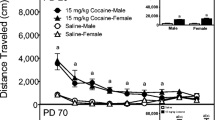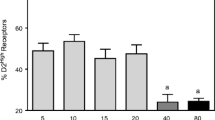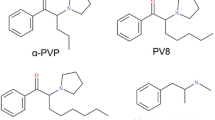Abstract
Relationships between aging effects on apomorphine (AP)-induced stereotypy and AP concentrations in plasma and brain were studied in rats. In two separate behavioral studies, four groups of male Wistar rats (3, 6, 20, and 43 weeks of age) and two groups of female Wistar rats (5 and 35 weeks of age) were used, respectively: The former groups were administered 3 mg/kg, AP SC and the latter 10 mg/kg AP SC. For the pharmacokinetic study, 5- and the 35-week female rats were injected with 10 mg/kg AP SC. In older rats, AP-induced stereotypy scores were less at the early stage of the observation period, and the onset of biting was slower and of longer duration. In 35-week rats, mean plasma AP concentrations were higher at 10–150 min and brain AP concentrations were lower at 5 and 10 min and higher at 30 and 90 min after injection. The longer duration of stereotypy in older rats seems to be due to the higher plasma or brain AP concentrations. The lower magnitude of stereotypy early after administration in older rats can be explained by the difference in brain AP concentrations, but cannot be fully explained by the difference in plasma levels only. It is suggested that other mechanisms, such as the decrease of dopaminergic binding sites, might also contribute to age differences in stereotypy.
Similar content being viewed by others
References
Beatty WW, Holzer GA (1978) Sex differences in stereotyped behavior in the rat. Pharmacol Biochem Behav 9:777–783
Burkman AM, Notari RE, van Tyle WK (1974) Structural effects in drug distribution: Comparative pharmacokinetics of apomorphine analogues. J Pharm Pharmacol 26:493–507
Carlson KG, Almasi J (1978) Sensitivity to apomorphine in the guinea pig as function of age and body weight. Psychopharmacology 57:279–282
Cotzias GC, Papavasiliou PS, Tolosa ES, Mendez JS, Bell-Midura M (1976) Treatment of Parkinson's disease with aporphines. New Engl J Med 294–572
Crooks J, O'Malley K, Stevenson IH (1976) Pharmacokinetics in the elderly. Clin Pharmacokinet 1:280–296
Ernst AM (1965) Relationship between the action of dopamine and apomorphine and their O-methylated derivatives upon the CNS. Psychopharmacologia 7:391–399
Ernst AM, Smelik PG (1966) Site of action of dopamine and apomorphine on compulsive gnawing behavior in rats. Experientia 22:837–838
Ernst AM (1967) Mode of action of apomorphine and dexamphetamine on gnawing compulsion in rats. Psychopharmacologia 10:316–323
Fuxe K, Ungerstedt U (1970) Histochemical, Biochemical and functional studies on central monoamine neurons after acute and chronic amphetamine administration. In: Costa E, Garratini S (eds) Amphetamines and related compounds. Raven, Press, New York, pp 257–288
Gorrod JW (1974) Absorption, metabolism and excretion of drugs ingeriatric subjects. Gerontol Clin 16:30–42
Govoni G, Spano PF, Trabucchi M (1978) 3H-haloperidol and 3H-spiroperidol binding in rats striatum during aging. J Pharm Pharmacol 30:448–49
Hayes MJ, Langman MJS, Short AH (1975) Changes in drug metabolism with increasing age. II. Phenytoin clearance and protein binding. Br J Clin Pharmacol 2:72–79
Kato R, Vassanelli P, Frontino G, Chiesara E (1964) Variation in the activity of liver microsomal drug-metabolising enzymes in rats in relation to age. Biochem Pharmacol 13:1037–1051
Kaul PN, Brachmann-Hansen E, Way EL (1961) Biological disposition of apomorphine II. Urinary excretion and organ distribution of apomorphine. J Pharm Sci 50:244–247
Klotz U, Avant GR, Hoyumpa A, Schenker S, Wilkinson GR (1975) The effects of age and liver disease on the disposition and elimination of diazepam in adult man. J Clin Invest 55:347–359
Lal S, Sourkes TL (1973) Ontogeny of stereotyped behavior induced by apomorphine and amphetamine in the rat. Arch Int Pharmacodyn Ther 202:171–182
Nakano S, Hara C, Ogawa N (1980) Circadian rhythm of apomorphine-induced stereotypy in rats. Pharmacol Biochem Behav 12:459–461
Rotrosen J, Angrist BM, Wallach MB, Gershon S (1972) Absence of serotonergic influence on apomorphine-induced stereotypy. Eur J Pharmacol 20:133–135
Sahakian BJ, Robbins TW, Morgan MJ, Iversen SD (1975) The effects of psychomotor stimulants on stereotypy and locomotor activity in socially deprived and control rats. Brain Res 84:195–205
Severson JA, Finch CE (1980) Reduced dopaminergic binding during aging in the rodent striatum. Brain Res 192:147–162
Smith RC, Leelavathi DE, Lauritzen MA (1978) Behavioral effects of dopamine agonist increase with age. Commun Psychopharmacol 2:39–43
Smith RV, Wilcox RE, Soine WH, Riffee WH, Baldessarini RJ, Kula NS (1979) Plasma levels of apomorphine following intravenous, intraperitoneal and oral administration in mice and rats. Res Commun Chem Pathol Pharmacol 24:483–498
Triggs EJ, Nation RL (1975) Pharmacokinetics in the aged: a review. J Pharmacokinet Biopharmacol 3:287–418
Triggs EJ, Nation RL, Long A, Ashley JJ (1975) Pharmacokinetics in the elderly. Eur J Clin Pharmacol 8:55–62
Watanabe H, Nakano S, Ogawa N (1980) Determination of apomorphine in plasma by selected ion monitoring. Biomed Mass Spectrom 7:160–163
Watanabe H, Nakano S, Ogawa N (1981) Determination of apomorphine in brain by GC-MS-MID method. J Chromatogr, in press
Author information
Authors and Affiliations
Rights and permissions
About this article
Cite this article
Watanabe, H., Nakano, S. & Ogawa, N. Age difference in apomorphine-induced stereotypy in rats: Relationship to plasma and brain concentrations. Psychopharmacology 76, 57–61 (1982). https://doi.org/10.1007/BF00430756
Received:
Accepted:
Issue Date:
DOI: https://doi.org/10.1007/BF00430756




